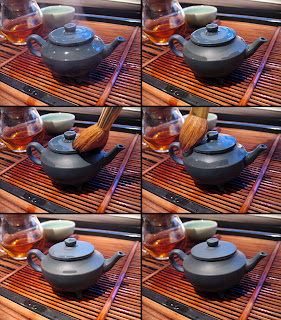
A Divine Taiwanese Traditional High Fired Oolong. Michael (Tea Galley) and I were speechless to each others from the experience. Our heads nodded, satisfaction is on our faces. He generously vacuumed 7g from his less-than-25g-collection, announcing this will be a fine enjoyment at home, alone!
Aged High Fire oolong is my first love. Aged high graded Taiwanese Oolong is "By faith, not by quest." This traditional highly crafted workmanship in Taiwan is fading year by year. http://chadao.blogspot.com/2006/04/yixing-pot-old-and-new.html
Although there is still a large number of older generation in Hong Kong and SE Asia which still praise for this gem. Sadly, the newer tea communities can hardly get their hands on this highly crafted, time consuming products. If we thought puerh is difficult, High fired aged oolong will be overwhelming....
The 4 main keys to the process are:
1. Picking - the right tea, the right place and the right timing.
2. First processing - After processing the tea. The first firing to prepare for the first 6 months aging.
3. Fine roasting - A refining steps of roasting to bring out the best of the tea for storage in Mid-Autumn.
4. Storage - A complete moisture sealing and aging.
To obtain the best effect, the master roaster will refine firing the tea for over 48 hrs or more, in small steps. Not to over roast, but to bring out the tea like an opera. With height and drama, the tea will give you an emotional ride. And this is exactly what this Mystery tea had given me.
A high elevation, high quality Lishan ( I am guessing ) from older bushes. The tea should be at least 2 years aged or older. Strong, large pallets with oily sheen covering each of them.
Heated pot aroma of grain, seaweed and clean refreshing high mountain air. With floral of orchid rushing from the back.
Rinse and sit for 30 sec. Rolling water. Set aside for 4th brew after cleanser: The smell of ocean and dried moss, followed by sweet fruits and blossom.
1st brew. 15 sec. Gentle rim pouring: Seaweed, honey and roasted sun dried plums. Chinese medicine at the back. Clean and refreshing.
My wife wrote a Chinese calligraphy for it: "Body in Forest, Mind in Ocean."
2nd. 30 sec. I like this stronger: Floral, orchid, dried moss, fresh peaches. Strong on the front and sweet at the back. Long lasting aroma filling my breath, mixing with the first brew.
3rd. 45 sec. Powerful. Chinese medicine with deep floral overall, roasted grain. I am blushing with sweat on my back.
4th. 45 sec. Boiling water. Soft rim. Bitterness turns into wave of sweetness. Ripe honeydew melon, floral. deep mountain creek. Sunshine on moist moss. Summer Afternoon high mountain clear creek cool water. Refreshing. Another calligraphy from her: "Raining day, praising a cup of tea. Cloudy afternoon, flowers blossoming in my garden."
I am very impressed. Both from her reaction and the tea. We looked at each other and nodded in tranquility for a moment.
The rinse now. Green melon and spring blossom, light and refreshing. We ended the afternoon quite drunk from the experience.
Aroma lasted for a long couple of hours, leaving us with a very deep impression of what a great tea can do to your mind and body. And the timeless tradition of all the right combination to make a tea for the Mandarins.















































